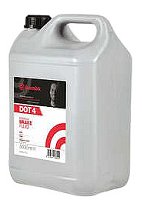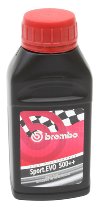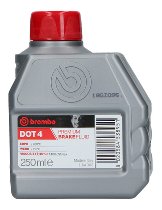Thanks to its 40 years of experience in racing, Brembo is able to offer the aftermarket a range of brake fluids that guarantees optimum performance for every brake system.
Clear advantages: Better fluidity and higher boiling point
Brake discs, brake calipers and brake cylinders are important components of any hydraulic brake system that would not function without brake fluid. The brake fluid is often neglected, only checked superficially and often only topped up instead of being changed as prescribed by the manufacturer.
A comparison of brake fluids
The product line of Brembo Premium brake fluids meets and exceeds the standards for class 4, 5.1 and 6 brake fluids and therefore guarantees safe braking in every case.
Brembo comparison parameters
- DOT parameters Brembo target value
- DOT 4 ERBP ≥ 260°C ≥ 230°C
- Wet ERBP ≥ 165°C ≥ 155°C
- DOT 5.1 ERBP ≥ 260°C ≥ 260°C
- Wet ERBP ≥ 180°C ≥ 180°C

When and why does the brake fluid need to be changed?
The braking distance increases over time. The brake fluid deteriorates relatively quickly and loses some of its original properties. This is mainly due to the fact that it is hygroscopic, i.e. it tends to bind water, which later (even before reaching the boiling point indicated on the container) turns into water vapor and causes a significant increase in brake lever travel. This leads to a loss of performance and braking force.
It is therefore generally advisable to change the brake fluid according to the manufacturer's instructions, which may vary depending on the product used. Brake fluid spoils relatively quickly even with small amounts of water. Therefore, a change is generally recommended after 2 to 3 years. In the event of vapor bubble formation (so-called vapor lock, premature boiling of the fluid due to moisture) or difficult operating conditions, which can accelerate the deterioration of the product, it is of course better to change the brake fluid earlier.</p
Instructions for changing the brake fluid
Vapour lock resistance, corrosion protection and boiling point above the required standards: Brake fluids from Brembo focus on quality for safe braking under all conditions.
Before replacing the brake pads, the brake fluid level should be checked, especially if the brake pads have no wear indicator. Before refitting the brake pistons, remove the excess brake fluid from the reservoir. This prevents fluid from escaping from the reservoir. If the brake fluid level is higher than expected, check whether it has already been topped up.
The ideal brake fluid level is between the minimum mark (which should never be reached) and the maximum mark. But be careful: If the fill level approaches the minimum, this is not necessarily due to insufficient fluid. Rather, worn friction materials such as brake discs and brake pads can lead to more brake fluid circulating in the circuit than is in the reservoir. It is therefore advisable to check the condition of the other components of the brake system before refilling.
Avoid dripping brake fluid on the fairing parts, as it will damage the paintwork.
Leave the lid of the brake fluid reservoir open only long enough to check or top up the fluid, as brake fluid is hygroscopic (it attracts moisture). If possible, use a new or recently opened brake fluid bottle.
Finally, an important note for all those who like to do it themselves“: Brake fluid is highly corrosive by nature and should therefore be handled with the utmost care. Contact with skin, clothing, mechanical parts and the bodywork must be avoided at all costs.
-
33.92 € *Content: 0.50 liter (67.84 €* / 1.00 liter)Unit: piece
-
47.50 € *Content: 5.00 liter (9.50 €* / 1.00 liter)Unit: piece
-
11.78 € *Content: 0.25 liter (47.12 €* / 1.00 liter)Unit: piece
-
12.90 € *Content: 1.00 liter (12.90 €* / 1.00 liter)Unit: piece
-
14.90 € *Content: 1.00 liter (14.90 €* / 1.00 liter)Unit: piece
-
6.09 € *Content: 0.25 liter (24.36 €* / 1.00 liter)Unit: piece
-
9.84 € *Content: 0.50 liter (19.68 €* / 1.00 liter)Unit: piece
-
-
8.50 € *Content: 0.50 liter (17.00 €* / 1.00 liter)Unit: piece















